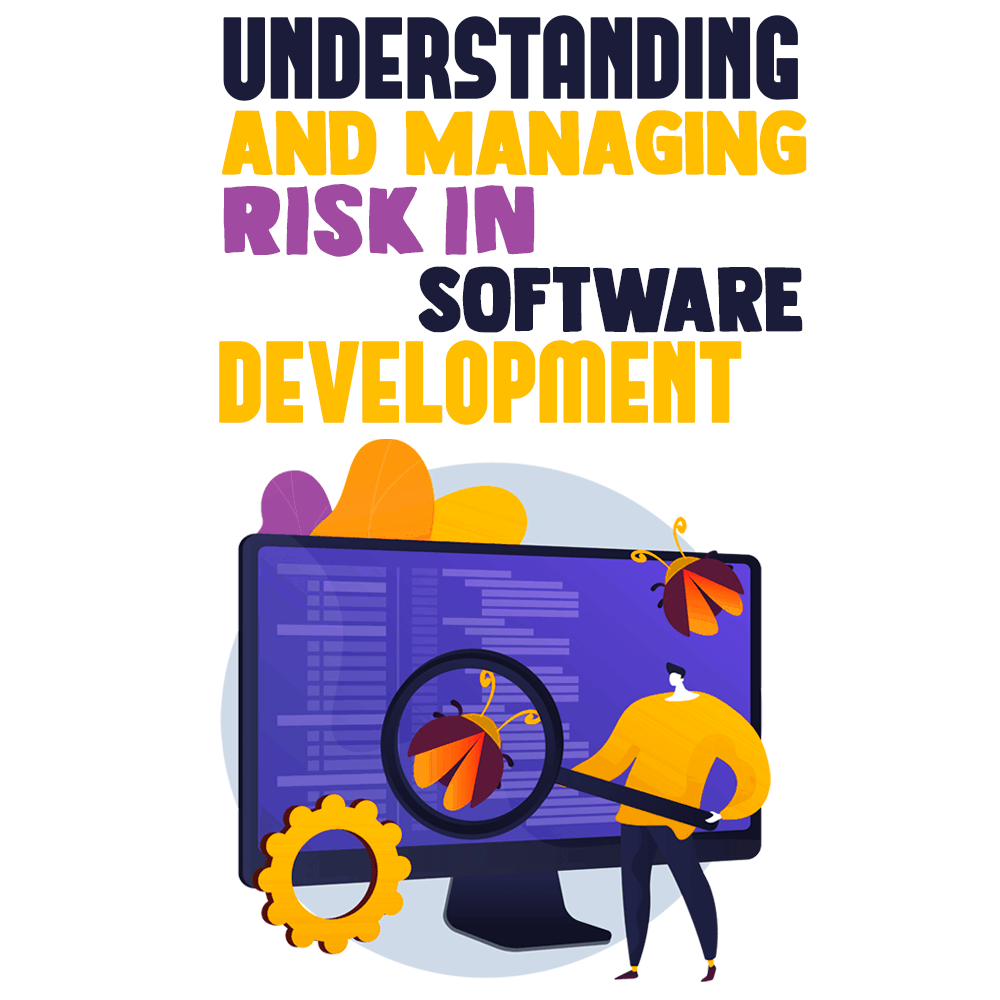
Risk management includes understanding the size and probability of the loss from possible risks. You can minimize the risk after a successful evaluation.
In this post I will show you the importance of risk management and offer you strategies for creating a successful risk management plan. A solid risk management plan will help you eliminate risk from your projects, putting you on the path to success.
Types of Risk in Software Development
Before we see what risk management involves and how you can devise an effective risk management strategy, we should examine the types of risk involved in software development. Generally, we can divide risk into the following categories.
New, Unproven Technologies
Many teams introduce new tools and technologies for their projects. Nonetheless, continuously changing the tools, standards, protocols, techniques, and development system will increase the technological risks because your team requires proper training and understanding of a tool before they implement it into the development process.
This problem goes beyond just employees on your team lacking experience and training. It also includes the risk of employees not knowing which technology to use in a particular situation.
User and Functional Requirements
Choosing the relevant software will define the success of your project. However, sometimes you need different functions and features to perform various tasks.
Moreover, while going through prototyping, discovery, and integrating processes, you may need modification to the users’ requirements, which can cause problems with the functional requirements of the project. Due to requirements changes, your software development plan might fail, leading to various risks such as poor quality, bad user experience, bugs and errors, slow interface, and other similar issues.
Application and System Architecture
When you choose the wrong component, platform, or architecture, the project can result in a disaster. Therefore, it is vital to include experts on your team. A professional developer can understand the technological risks and contribute to the development of a successful project. When choosing an expert in the field, make sure that they have knowledge about the important architecture and components.
Performance
While performing risk management tasks, your team should focus on your users’ and partners’ expectations. Ill-equipped or undertrained teams can jeopardize the success of a project. Performance could also be a significant risk factor if teams don’t have the necessary resources to complete a project. Identifying the potential shortcomings of the team and all the barriers that stand in the way could help you more accurately plan for the risk that may arise along the way,
Organizational problems have a huge influence on the project results. You need to plan the development process after considering the expectations of your customers and the needs of your team. You need to choose a well-experienced and capable team to satisfy your clients. Furthermore, you should equip them with appropriate resources.
What Risk Management in Software Development Involves

Identify
Before managing the risk, you need to identify and evaluate it in the project. For that purpose, understand the type and intensity of the problem. However, identification of the risk is not an easy task. You need relevant data to predict the potential effects of your decisions.
Classify
Once you identify risks, it’s time to organize them. Putting risks into different categories helps you see the bigger picture. There is no single rule for classification, so you can come up with your own ideas. Here are a few tried and tested methods to make the grouping task simple.
For starters, you can arrange risks based on their magnitude or level of intensity. For instance, you can separate risks having a higher impact on your software development process from the ones having a lower impact. This will help avoid any confusion, and you can keep track of them.
Another way to organize your issues is by timescale. Timescale, in this context, indicates the time when the problem will occur. You can also classify risks by origin of the issue, nature of the impact, and affected groups or projects.
Plan
Once you categorize the risk based on the tasks, create a risk management plan. This plan will help you record and manage your risks. Including risk management in your project management plan will enable you to respond instantly and eliminate the problem. A risk management plan will include a list of threats and methods to eliminate those threats from your project.
Later in this post, I will offer you concrete tips on the steps you need to take to manage the risk.
Monitor
Monitoring your risks is essential after you create a plan. A risk management plan will help you identify the risks, and it includes ways to eliminate them. However, you need to keep track of those risks to understand the progress.
Keeping track of the risks will open new opportunities. Addressing some potential risks could make your business more capable in areas you hadn’t previously considered. This could create new opportunities and forge a path to develop specific expertise. Also, it will help you develop new upgrades. Successful risk management includes tracking for new risks, evaluating your progress with the plan, and upgrading plans and techniques to solve the problems.
Mitigate
Reducing risk factors in advance requires accurate data collection and insights. These insights will help you evaluate the tasks and the results. This data consists of quantitative metrics such as click-through rates, visitor count, or time on each page of your site.
Measuring all of these metrics will enable you to immediately respond beforehand. Furthermore, you need to design a contingency plan to handle the risk. These plans will help you monitor future risks and include suitable responses to solve those problems.
Communicate
The risk management process requires effective communication within the teams. Also, you need to be transparent with the stakeholders, clients, and developers. When your team can easily share information and generate feedback about the risk, they can increase their chances of resolving the problem.
Steps To Manage Risk
As we saw earlier, a good risk management plan involves recording and addressing risks and includes a list of threats as well as methods to eliminate them. As promised, here are some steps you should consider when you prepare your risk management plan.
Identify risk tolerance. Before starting the project, you should communicate with your team and brainstorm for potential risks. Have meetings with your developers and designers so they can identify the factors that can trigger the problems.
Decide which risks to manage. After you list the potential risks that might occur during the development process, you can categorize them, prioritize them, and identify those you can easily resolve.
Identify risk triggers. After the evaluation of the project, you should identify the triggers for the listed risks. An expert project manager can analyze the risks and understand how they will affect the project. In this phase, you will consider the complexity of the project, testing qualities, and dependencies of the project.
Create visual representations. A good risk management plan will keep you on track throughout the project and direct your team toward defined goals. To better visualize your plan, you can use tools that provide a visual representation of the condition. The tools include risk matrix, assumption grid, and roam board. Let’s take a closer look at them:
- Risk Matrix — This tool highlights risks in a diagram, enabling you to identify the intensity at a glance. You can construct a risk matrix by conducting a risk analysis and risk evaluation. Then, place the values on a coordinate system. A risk matrix can help you evaluate the efficiency of your data, not to mention, creating a risk matrix doesn’t involve any complex processes.
- Assumption Grid — An assumption grid allows you to identify risks. Consider these risks as assumptions. In this tool, you place an assumption in two axes. These are high impact and low impact. By visualizing your assumptions using an assumption grid, you prioritize your tasks, make decisions, and overcome uncertainties. You can better organize your ideas and identify risks. This tool provides a table with risk levels for better understanding.
- ROAM Board — ROAM board is a framework to highlight risks. You and your team can identify these risks in a shared space. Furthermore, the tool will set priorities with different colors. Using a ROAM board to identify problems beforehand will help you drive cost effective solutions. The ROAM framework can help you resolve and mitigate problems.
This plan may also include a table with the following columns:
- Definition of the risk
- Triggers
- Probability
- The severity of the risk
- Priority of the risk
- Strategy to eliminate the risk
- Alternate strategy
- Action plan to implement the strategy
Overall, the idea is to choose a visualization that serves your particular project and circumstances the best, highlighting areas of importance to you.
Risk Management Is Worth the Effort
 For the success of your software development project, you cannot ignore the risk management process. It is essential to identify, categorize and prioritize, and create an action plan to eliminate the potential risks.
For the success of your software development project, you cannot ignore the risk management process. It is essential to identify, categorize and prioritize, and create an action plan to eliminate the potential risks.
Furthermore, you should update your risk management plan as the project advances. This requires reevaluating the risks on a daily basis and communicating with your development and designing team.
Risk management might seem complex at first, but once everything is set and you have a good understanding of what’s involved, the process is simplified. The benefits from risk management are certainly worth it.
Long hours behind a desk don’t count for much anymore. We live in an era where output and productivity are the only key drivers of success. Our ability to maintain sustained focus may be limited to four or five hours a day, so optimizing your day around high-impact tasks is crucial. Learn how to supercharge your day with these productivity hacks.
